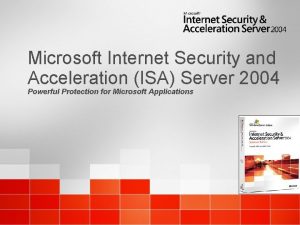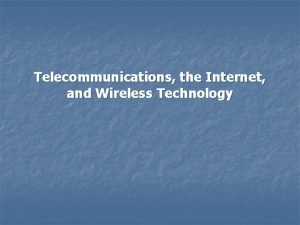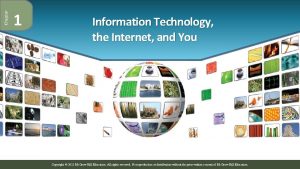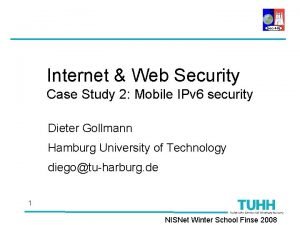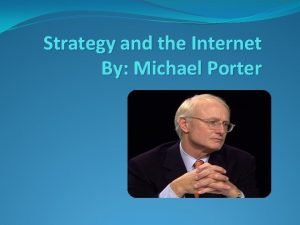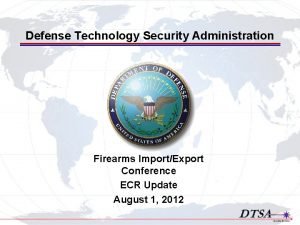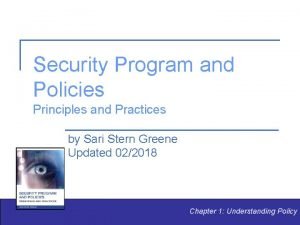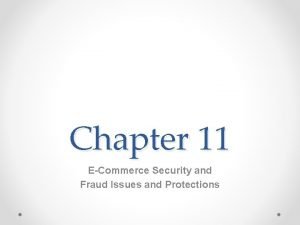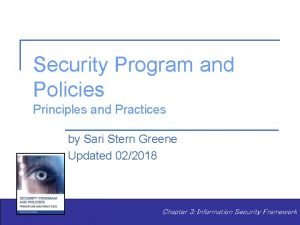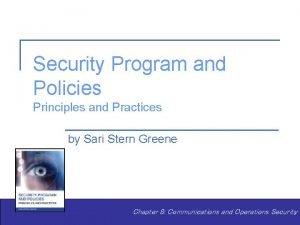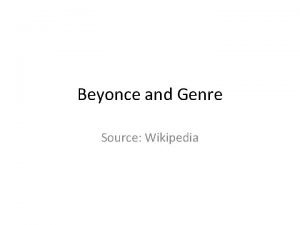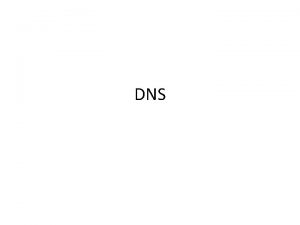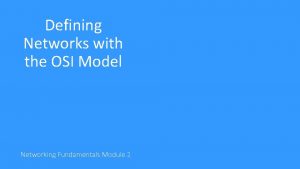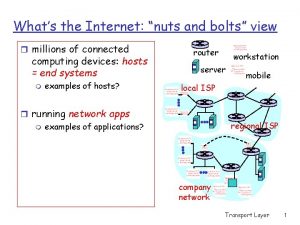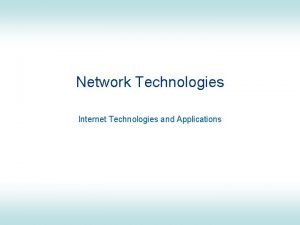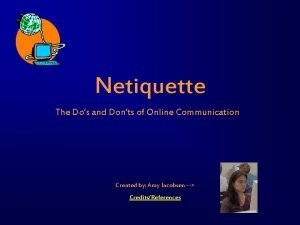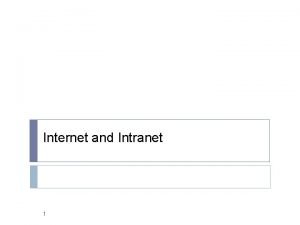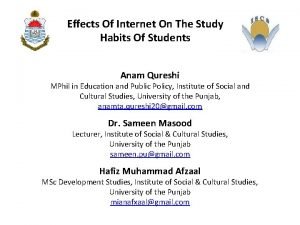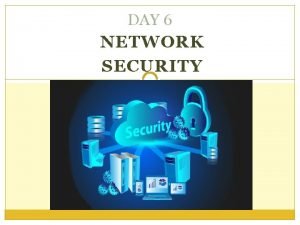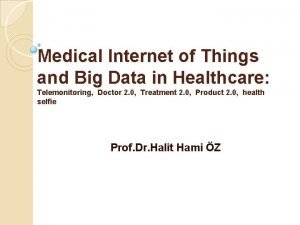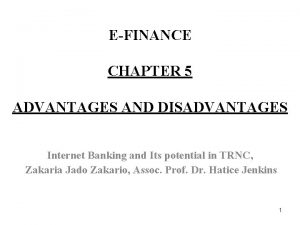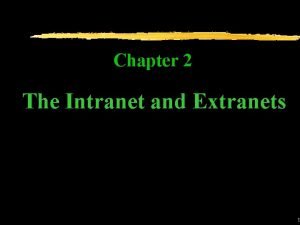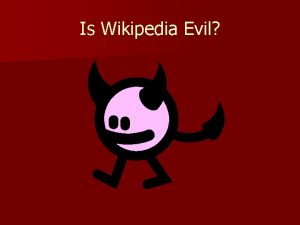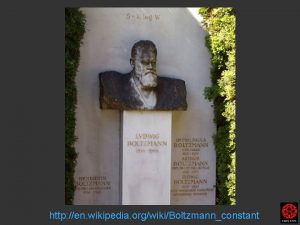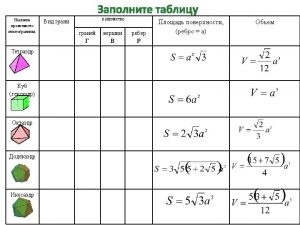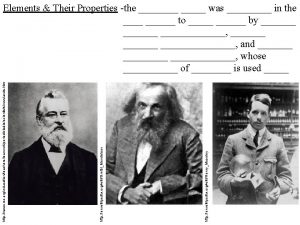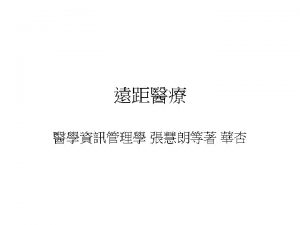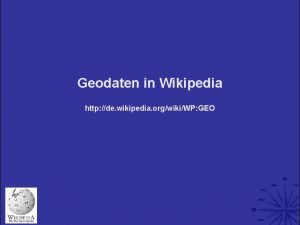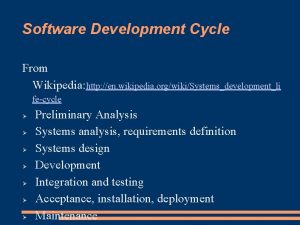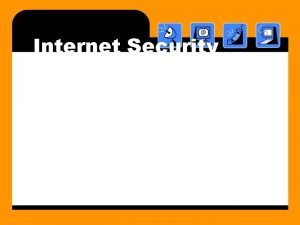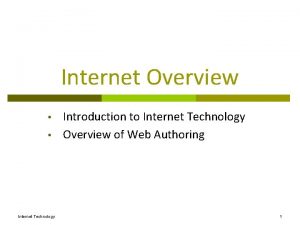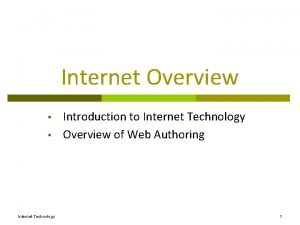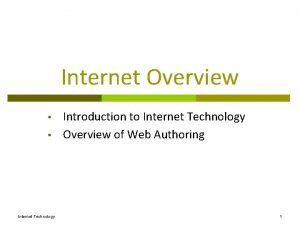Internet Technology and Security http en wikipedia orgwikiInternetProtocolSuite




































































- Slides: 68

Internet Technology and Security http: //en. wikipedia. org/wiki/Internet_Protocol_Suite

http: //xkcd. com/742/

Store and Forward Networking Leased Dialup http: //en. wikipedia. org/wiki/BITNET Clipart: http: //www. clker. com/search/networksym/1

Research Networks 1960 -1980’s • • • December 1969 How can we avoid having a direct connection between all pairs of computers? How to transport messages efficiently? How can we dynamically handle outages? August 1972 http: //som. csudh. edu/fac/lpress/history/arpamap s/

Heart, F. , Mc. Kenzie, A. , Mc. Quillian, J. , and Walden, D. , ARPANET Completion Report, Bolt, Beranek and Newman, Burlington, MA, January 4, 1978. http: //som. csudh. edu/fac/lpress/history/arpamaps/arpanetmar 77. jpg

Efficient Message Transmission: Packet Switching • • Challenge: in a simple approach, like store-and-forward, large messages block small ones Break each message into packets Can allow the packets from a single message to travel over different paths, dynamically adjusting for use Use special-purpose computers, called routers, for the traffic control

Hello there, have a nice day. Hello ther (1, csev, daphne) e, have a (2, csev, daphne) nice day. (3, csev, daphne) Packet Switching Postcards

1 2 3

Packet Switching Postcards e, Hello have ther a (3, (2, (1, csev, daphne) nice day. Hello there, have a nice day.

Shared Network Router Local Area Network Wide Area Network Cable or DSL Clipart: http: //www. clker. com/search/networksym/1

• • • Shared Networks In order to keep cost low and the connections short geographically - data would be forwarded through several routers. Getting across the country usually takes about 10 “hops” Network designers continually add and remove links to “tune” their networks Source: http: //en. wikipedia. org/wiki/Internet_Proto col_Suite

• • • Layered Network Model A layered approach allows the problem of designing a network to be broken into more manageable sub problems Best-known model: TCP/IP—the “Internet Protocol Suite” There was also a 7 layer OSI: Open System Interconnection Model Application Layer Web, E-Mail, File Transfer Transport Layer (TCP) Reliable Connections Internetwork Layer (IP) Simple, Unreliable Link Layer (Ethernet, Wi. Fi) Physical Connections

Internet Standards • • The standards for all of the Internet protocols (inner workings) are developed by an organization Internet Engineering Task Force (IETF) www. ietf. org Standards are called “RFCs” “Request for Comments” Source: http: //tools. ietf. org/html/rfc 791

Layered Architecture • • The Physical and Internet Layers are like trucks and trains - they haul stuff and get it to the right loading dock - it takes multiple steps The Transport layer checks to see if the trucks made it and send the stuff again if necessary Source: http: //en. wikipedia. org/wiki/Internet_Protocol_Suite

Link Layer (aka Physical Layer) • • As your data crosses the country may use a different physical medium for each “hop” Wire, Wireless, Fiber Optic, etc. The link is “one hop” - Is it up or down? Connected or not? Very narrow focus - no view at all of the “whole Internet” Source: http: //en. wikipedia. org/wiki/Internet_Protocol_Suite

Link Layer Addresses • Many physical layer devices have addresses built in to them by the manufacturer • • Ethernet Wireless Ethernet (Wifi)

Internetwork Layer (IP) Application Layer Web, E-Mail, File Transfer Transport Layer (TCP) Reliable Connections Internetwork Layer (IP) Simple, Unreliable Link Layer (Ethernet, Wi. Fi) Physical Connections

Internet Protocol Layer • • • Goal: Gets your data from this computer to the other computer half way across the world Each router knows about nearby routers IP Is best effort - it is OK to drop data if things go bad. . . Source: http: //en. wikipedia. org/wiki/Internet_Protocol_Suite

IP Addresses • • • The IP address is the worldwide number which is associated with one particular workstation or server Every system which will send packets directly out across the Internet must have a unique IP addresses are based on where station is connected IP addresses are not controlled by a single organization address ranges are assigned They are like phone numbers – they get reorganized once in a great while


IP Address Format • • Four numbers with dots - each number 1 -255 (32 bits) Kind of like phone numbers with an “area code” The prefix of the address is “which network” While the data is traversing the Internet - all that matters is the network number (734) 764 1855 Area code Network Number 141. 211. 144. 188 141. 211. *. *

While in the network, all that matters is the Network number. 67. 149. 102. 75 141. 211. 144. 188 To: 67. 149. *. * To: 67. 149. 94. 33 Clipart: http: //www. clker. com/search/networksym/1

No single router knows the whole network - just which way to send data to get it “closer” 67. 149. 102. 75 141. 211. 144. 188 To: 67. 149. *. * ? ? 67. 149. *. * 67. 149. 94. 33 Clipart: http: //www. clker. com/search/networksym/1

Router Tables Lists of where to send packets, based on destination network address; bandwidth on adjacent links; traffic on adjacent links; state of neighbor nodes (up or not); . . . To: 67. 149. *. * ? ? Updated dynamically Routers “ask each other” for information Clipart: http: //www. clker. com/search/networksym/1

IP Is Simple Thousands of network connections. Billions of bytes of data per seconds. Local Network 67. 149. *. * Thousands of user systems 100’s of servers One “area code” to keep track of inside the Internet. Clipart: http: //www. clker. com/search/networksym/1

DHCP = Dynamic Host Configuration Protocol Hello? Here I am What IP Address can I use? 141. 26. 14. 1 -100 141. 26. 14. 1 Use 141. 26. 14. 7

Non-Routable Addresses • • A typical home router does Network Address Translation (NAT) Your ISP gives your home router a real global routable address Your router gives out local addresses in a special range (192. 168. *. *) The router maps remote addresses for each connection you make from within your home network http: //en. wikipedia. org/wiki/Network_address_translation

141. 206. 14. 3 192. 168. 0. 20 192. 168. 0. 104 192. 168. 0. 1 35. 8. 2. 10 192. 168. 0. 20 192. 168. 0. 1 173. 44. 26. 18 NAT = Network Address Translation Clipart: http: //www. clker. com/search/networksym/1

http: //xkcd. com/742/

The perfect is the enemy of the good Le mieux est l'ennemi du bien. --Voltaire • • IP Does: Best effort to get data across bunch of hops from one network to another network IP Does Not: Guarantee delivery - if things go bad - the data can vanish Best effort to keep track of the good and bad paths for traffic tries to pick better paths when possible This makes it fast and scalable to very large networks - and ultimately “reliable” because it does not try to do too much

Domain Name System The Domain Name System convert user-friendly names, like www. umich. edu to network-friendly IP addresses, like 141. 211. 32. 166 Source: http: //en. wikipedia. org/wiki/Internet_Proto col_Suite

Domain Name System • • Numeric addresses like 141. 211. 63. 45 are great for Internet routers but lousy for people Each campus ends up with a lot of networks (141. 211. *. *, 65. 43. 21. *) Sometimes (rarely) the IP address numbers get reorganized When servers physically move they need new IP addresses

DNS: Internet Address Book • • The Domain Name System is a big fast distributed database of Internet names to Internet “phone numbers” IP Addresses reflect technical “geography” • • 141. 211. 63. 44 - read left to right like a phone number Domain names reflect organizational structure • • www. si. umich. edu - read right to left like postal address 2455 North Qaud, Ann Arbor, MI 48109, USA, Earth

. org . edu . com . nl umich. edu si. umich. edu http: //en. wikipedia. org/wiki/File: Domain_name_space. svg

Internetwork Layer (IP) Application Layer Web, E-Mail, File Transfer Transport Layer (TCP) Reliable Connections Internetwork Layer (IP) Simple, Scalable, Unreliable Link Layer (Ethernet, Wi. Fi) Physical Connections

Transport Layer Application Layer Web, E-Mail, File Transfer Transport Layer (TCP) Reliable Connections http: //en. wikipedia. org/wiki/Transmission_ Control_Protocol Internetwork Layer (IP) Simple, Scalable, Unreliable Link Layer (Ethernet, Wi. Fi) Physical Connections

Review: The Magic of IP • • What it does - Tries to get one packet across a 5 -20 of hops from one network to another network Keeps track of the good and bad paths for traffic - tries to pick better paths when possible But no guarantee of delivery - if things go bad - the data vanishes This makes it fast and scalable - and ultimately “reliable” because it does not try to do too "everything"

Internet Protocol • • So many links / hops So many routes Thinks can change dynamically and IP has to react (links up/down) IP can drop packets Source: http: //en. wikipedia. org/wiki/Internet_Proto col_Suite

Transport Protocol (TCP) • • Built on top of IP Assumes IP might lose some data In case data gets lost - we keep a copy of the data a we send until we get an acknowledgement If it takes “too long” - just send it again Source: http: //en. wikipedia. org/wiki/Internet_Proto col_Suite

Sender 1 2 3 4 5 Break Messages into Pieces Receiver

Receiver Sender 1 1 2 2 3 3 4 5 Break Messages into Pieces

Sender 1 Got 1 Where is 2? ? Receiver 1 2 3 4 5 Break Messages into Pieces 3

Sender Got 2 1 1 2 2 3 3 4 4 5 Break Messages into Pieces Receiver

Sender Got 4 Receiver 1 1 2 2 3 3 4 4 5 Break Messages into Pieces 5

Sender Got 5 Receiver 1 1 2 2 3 3 4 4 5 5 Break Messages into Pieces

Billions of computers connected to the internet; 100 thousands of routers. Hundreds of billions bytes of data enroute at any moment. Storage of enroute data done at the edges only! Clipart: http: //www. clker. com/search/networksym/1

Transport Protocol (TCP) • • The responsibility of the transport layer is to present a reliable end-to-end pipe to the application Data either arrives in the proper order or the connection is closed TCP keeps buffers in the sending and destination system to keep data which has arrived out of order or to retransmit if necessary TCP provides individual connections between applications

Application Layer Web, E-Mail, File Transfer Transport Layer (TCP) Reliable Connections Internetwork Layer (IP) Simple, Unreliable Link Layer (Ethernet, Wi. Fi) Physical Connections

TCP, Ports, and Connections http: //en. wikipedia. org/wiki/TCP_and_UDP_port http: //en. wikipedia. org/wiki/List_of_TCP_and_UDP_port_numbers

www. umich. edu Incoming E-Mail 25 Login 23 80 Web Server Personal Mail Box Clipart: http: //www. clker. com/search/networksym/1 blah 74. 208. 28. 177 443 109 110 Please connect me to the secure web server (port 443) on http: //www. dr-chuck. com

Common TCP Ports • Telnet (23) - Login • SSH (22) - Secure Login • HTTP (80) • HTTPS (443) - Secure • SMTP (25) (Mail) • http: //en. wikipedia. org/wiki/List_of_TCP_and_UDP_port_numbers IMAP (143/220/993) - Mail Retrieval

Application Protocols http: //en. wikipedia. org/wiki/Http http: //en. wikipedia. org/wiki/Pop 3

Application Protocol • Since TCP gives us a reliable pipe, what to we want to do with the pipe? What problem do we want to solve? • • • Mail World Wide Web Stream kitty videos Source: http: //en. wikipedia. org/wiki/Internet_ Protocol_Suite

HTTP - Hypertext Transport Protocol • • The dominant Application Layer Protocol on the Internet Invented for the Web - to Retrieve HTML, Images, Documents etc Extended to be data in addition to documents - RSS, Web Services, etc. . Basic Concept - Make a Connection - Request a document Retrieve the Document - Close the Connection http: //en. wikipedia. org/wiki/Http

HTTP Request / Response Cycle Web Server HTTP Request HTTP Response Browser Internet Explorer, Fire. Fox, Safari, etc. http: //www. oreilly. com/openbook/cgi/ch 04_02. html Source: http: //www. drchuck. com/

HTTP Request / Response Cycle Web Server GET /index. html HTTP Request <head>. . </head> <body> HTTP <h 1>Welcome to my Response application</h 1>. . </body> Browser Internet Explorer, Fire. Fox, Safari, etc. http: //www. oreilly. com/openbook/cgi/ch 04_02. html Source: http: //www. drchuck. com/

Internet Standards • • The standards for all of the Internet protocols (inner workings) are developed by an organization Internet Engineering Task Force (IETF) www. ietf. org Standards are called “RFCs” “Request for Comments” Source: http: //www. ietf. org/rfc 1945. txt


Source: http: //www. ietf. org/rfc 1945. txt

Application Layer Summary • • • We start with a “pipe” abstraction - we can send and receive data on the same “socket” We can optionally add a security layer to TCP using SSL Secure Socket Layer (aka TLS - Transport Layer Security) We use well known “port numbers” so that applications can find a particular application *within* a server such as a mail server, web service, etc

The Architecture of the Internet August 1972 Application Layer Web, E-Mail, File Transfer Transport Layer (TCP) Reliable Connections Internetwork Layer (IP) Simple, Unreliable Link Layer (Ethernet, Wi. Fi) Physical Connections

The Architecture of the Internet Application Layer Web, E-Mail, File Transfer Transport Layer (TCP) Reliable Connections Internetwork Layer (IP) Simple, Unreliable Link Layer (Ethernet, Wi. Fi) Physical Connections

Application Layer Web, E-Mail, File Transfer Transport Layer (TCP) Reliable Connections Internetwork Layer (IP) Simple, Unreliable Link Layer (Ethernet, Wi. Fi) Physical Connections http: //www. zakon. org/robert/internet/timeline/

Application Layer Web, E-Mail, File Transfer Transport Layer (TCP) Reliable Connections Internetwork Layer (IP) Simple, Unreliable Link Layer (Ethernet, Wi. Fi) Physical Connections http: //en. wikipedia. org/wiki/File: Internet_map_1024. jpg

The Internet: An Amazing Design • • • Hundreds of millions of computers Thousands of routers inside the Internet Hundreds of millions of simultaneous connections Trillions of bytes of data moved per second around the world And it works

The Internet • • It is said that “The Internet is the largest single engineering effort ever created by mankind” It was created to work in an organic way - to repair itself and automatically adjust when parts fail No one part of the Internet knows all of the Internet (like life) It is never 100% up - but it seems up all the time

Additional Source Information • • xkcd, http: //xkcd. com/742/, CC: BY-NC, http: //creativecommons. org/licenses/by-nc/2. 5/ Internet Protocol Suite Diagrams: Kbrose, Wikimedia Commons, http: //upload. wikimedia. org/wikipedia/commons/c/c 4/IP_stack_connections. svg, CC: BY-SA, http: //creativecommons. org/licenses/by-sa/3. 0/deed. en All your bases are belong to me: Karin Dalziel, Flickr, http: //www. flickr. com/photos/nirak/270213335/, CC: BY, http: //creativecommons. org/licenses/by/2. 0/deed. en Internet Map: The Opte Project, Wikimedia Commons, http: //upload. wikimedia. org/wikipedia/commons/d/d 2/Internet_map_1024. jpg, CC: BY, http: //creativecommons. org/licenses/by/2. 5/deed. en

ESEMPI DI ESERCIZI • • Il candidato illustri il significato del termine “Connessione” e discuta l’implicazione della definizione presentata nella modellazione di sistemi di comunicazione di rete. Il candidato illustri il concetto di “Rete locale” e spieghi anche in particolare il meccanismo con cui le reti locali gestiscono l’indirizzamento di un pacchetto e la differenza tra questa operazione e la corrispondente operazione svolta su una rete globale.
 Internet technology wikipedia
Internet technology wikipedia Security security security
Security security security Ms internet security and acceleration server
Ms internet security and acceleration server Chapter 1 information technology the internet and you
Chapter 1 information technology the internet and you Telecommunications, the internet, and wireless technology
Telecommunications, the internet, and wireless technology What are wireless devices and the wireless revolution
What are wireless devices and the wireless revolution Chapter 1 information technology the internet and you
Chapter 1 information technology the internet and you Rurom
Rurom Http wikipedia org
Http wikipedia org Grta6
Grta6 Wireless security in cryptography and network security
Wireless security in cryptography and network security E commerce security meaning
E commerce security meaning Http //mbs.meb.gov.tr/ http //www.alantercihleri.com
Http //mbs.meb.gov.tr/ http //www.alantercihleri.com Http //pelatihan tik.ung.ac.id
Http //pelatihan tik.ung.ac.id Http://www.meb.gov.tr internet
Http://www.meb.gov.tr internet What is internet
What is internet Wikipedia computer security
Wikipedia computer security Sky x technologies
Sky x technologies Assistive technology wikipedia
Assistive technology wikipedia Interface généralisé eai
Interface généralisé eai Security architecture for the internet protocol
Security architecture for the internet protocol Windows 7 internet security settings
Windows 7 internet security settings Heartbeat alert chapter 22
Heartbeat alert chapter 22 Angel binary internet security
Angel binary internet security Retina web security scanner
Retina web security scanner Internet security case study
Internet security case study Vpn vs peerblock
Vpn vs peerblock Strategy and the internet michael porter
Strategy and the internet michael porter Internet technology
Internet technology Osi architecture in network security
Osi architecture in network security Security guide to network security fundamentals
Security guide to network security fundamentals Explain about visa international security mode
Explain about visa international security mode Electronic mail security in network security
Electronic mail security in network security Cnss security model 27 cells example
Cnss security model 27 cells example Software security building security in
Software security building security in Security guide to network security fundamentals
Security guide to network security fundamentals Security guide to network security fundamentals
Security guide to network security fundamentals Dtsa elisa
Dtsa elisa Sdlc principles and practices
Sdlc principles and practices Security program and policies principles and practices
Security program and policies principles and practices Security program and policies principles and practices
Security program and policies principles and practices E commerce security and fraud issues and protections
E commerce security and fraud issues and protections Security program and policies principles and practices
Security program and policies principles and practices Security program and policies principles and practices
Security program and policies principles and practices Forces in dt
Forces in dt What genre of music is beyonce
What genre of music is beyonce Ram 42x70
Ram 42x70 Http and dns
Http and dns Which layer of the osi model includes vlans
Which layer of the osi model includes vlans Http://anatomy and physiology
Http://anatomy and physiology Web and http in computer networks
Web and http in computer networks Menticom
Menticom Discussing advantages and disadvantages
Discussing advantages and disadvantages Bulk tv and internet
Bulk tv and internet Nuts and bolts view
Nuts and bolts view The press television and radio
The press television and radio Aim lans
Aim lans What are the dos and don'ts of online interaction
What are the dos and don'ts of online interaction Intranet 1
Intranet 1 Effects of internet use and study habits
Effects of internet use and study habits Raman wants to send a few photographs
Raman wants to send a few photographs Give two piece of advice to avoid computer addiction
Give two piece of advice to avoid computer addiction Cloud computing presentation
Cloud computing presentation Problem solution essay definition
Problem solution essay definition Medtech and the internet of medical things
Medtech and the internet of medical things Medical internet of things and big data in healthcare
Medical internet of things and big data in healthcare Internet services and tools
Internet services and tools E banking advantages and disadvantages
E banking advantages and disadvantages Intranet vs extranet
Intranet vs extranet


